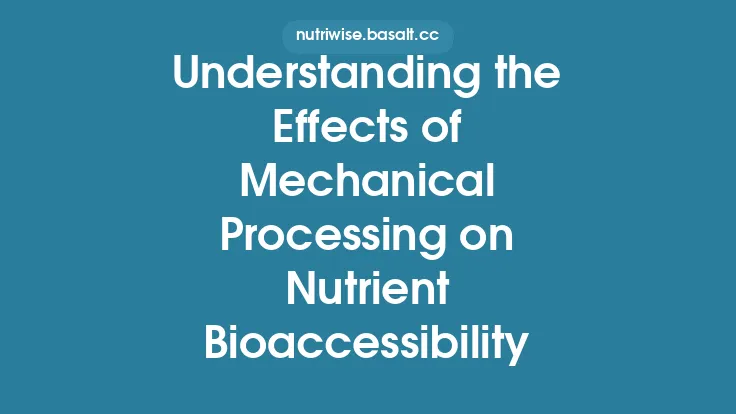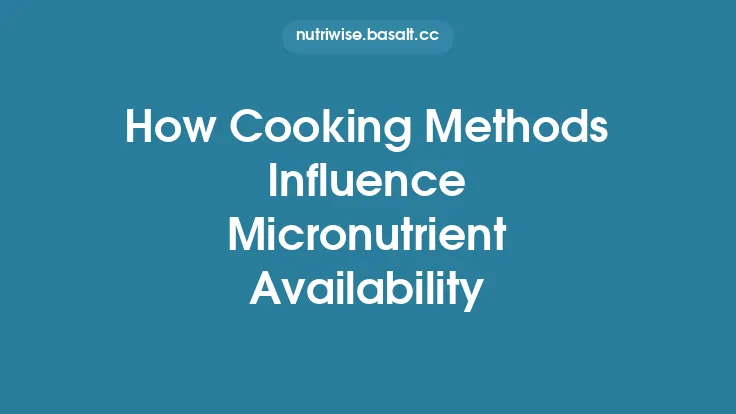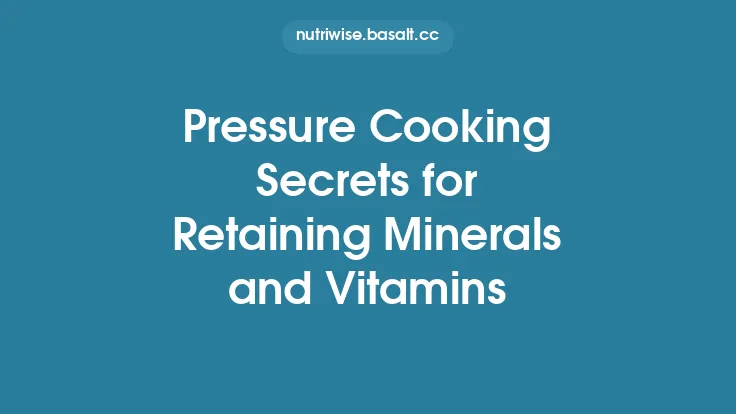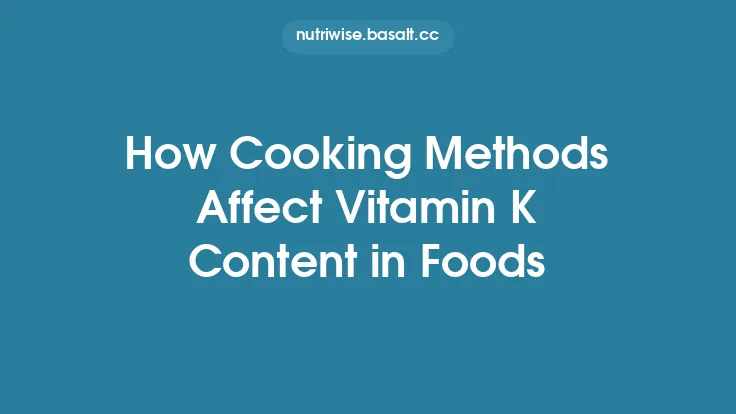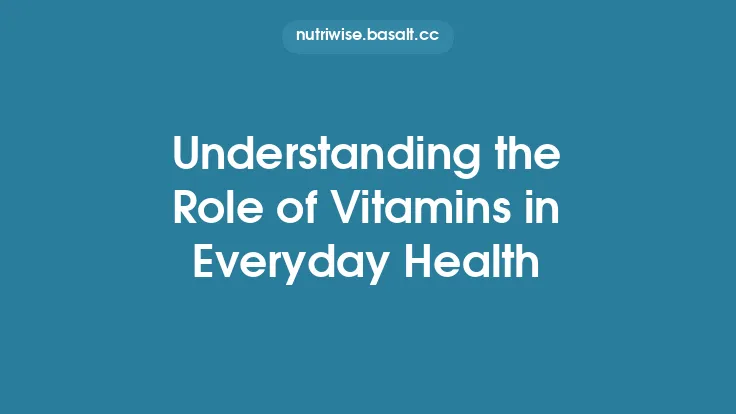Cooking transforms the raw ingredients on our plates, but the way we apply heat can either preserve or diminish the nutritional power hidden within vegetables, fruits, grains, and legumes. While the term *bioaccessibility refers to the proportion of a nutrient that is released from the food matrix during digestion and becomes available for absorption, the actual amount that reaches the bloodstream (bioavailability*) depends on many downstream factors. The cooking method you choose—whether a gentle steam, a rapid boil, a high‑temperature roast, or a precise sous‑vide—directly influences how much of the vitamins and phytonutrients are liberated, degraded, or rendered inert. Understanding the physicochemical mechanisms at play helps food scientists, chefs, and health‑conscious consumers make informed decisions that maximize the nutritional return of everyday meals.
Overview of Bioaccessibility vs. Bioavailability
| Concept | Definition | Primary Determinants | Typical Measurement |
|---|---|---|---|
| Bioaccessibility | Fraction of a nutrient released from the food matrix during gastrointestinal digestion and available for intestinal uptake. | Food matrix disruption, solubility, enzymatic hydrolysis, pH changes, presence of antagonists or enhancers. | In‑vitro digestion models (e.g., INFOGEST), dialyzability assays. |
| Bioavailability | Portion of the bioaccessible nutrient that is actually absorbed, transported, and utilized by the body. | Intestinal transporters, metabolic conversion, first‑pass metabolism, systemic distribution. | Human or animal feeding trials, isotopic tracer studies. |
Cooking primarily modulates bioaccessibility by altering cell wall integrity, enzyme activity, and the chemical environment of the food. The subsequent steps that determine bioavailability are largely beyond the scope of cooking alone, but the initial release is a prerequisite for any downstream absorption.
Thermal Effects on Vitamin Stability
Heat can cause both chemical degradation (e.g., oxidation, decarboxylation) and physical changes (e.g., melting, volatilization). The susceptibility of a vitamin to thermal loss depends on:
- Molecular structure – conjugated double bonds (as in β‑carotene) are prone to isomerization; labile functional groups (e.g., the thio‑group in thiamine) are heat‑sensitive.
- Reaction environment – presence of oxygen, water activity, and pH can accelerate or mitigate degradation pathways.
- Temperature‑time profile – higher temperatures for short periods may cause less loss than moderate temperatures for extended times (the “thermal dose” concept).
For example, vitamin C (ascorbic acid) undergoes irreversible oxidation to dehydroascorbic acid at temperatures above 70 °C, especially in aqueous, oxygen‑rich conditions. In contrast, vitamin D (cholecalciferol) is relatively heat‑stable up to 150 °C but can degrade under prolonged exposure to intense UV light.
Water‑Based Cooking Techniques and Leaching Phenomena
Boiling, blanching, and poaching immerse food in water, which can both facilitate matrix softening and promote leaching of water‑soluble nutrients. Key points:
- Cell wall swelling: Heat causes pectin and hemicellulose to solubilize, expanding intercellular spaces and allowing easier diffusion of nutrients.
- Leaching loss: Vitamins C, B‑complex, and many phenolic compounds dissolve into the cooking water. The magnitude of loss is proportional to the water‑to‑food ratio, cooking duration, and surface area.
- Mitigation strategies: Using minimal water, covering the pot to limit oxygen exposure, and re‑using the cooking liquid (e.g., in soups) can retain leached nutrients.
A typical 10‑minute boil of broccoli results in ~30 % loss of vitamin C, whereas a 2‑minute blanch followed by immediate cooling retains >80 % of the same vitamin, illustrating the importance of time control.
Dry‑Heat Methods: Roasting, Grilling, and Frying
Dry‑heat techniques rely on conduction, convection, and radiation to raise food temperature without a bulk liquid phase. Their impact on nutrients is multifaceted:
- Matrix rupture: High temperatures cause rapid denaturation of structural proteins and breakdown of cell walls, often enhancing the release of lipophilic compounds (e.g., carotenoids).
- Oxidative stress: Exposure to air and high heat can generate reactive oxygen species, leading to oxidation of sensitive vitamins and polyphenols.
- Maillard reactions: While beneficial for flavor, these reactions can bind amino acids and reducing sugars, sometimes trapping certain phytonutrients in complex matrices that are less bioaccessible.
- Frying: The presence of oil creates a lipid medium that can solubilize fat‑soluble vitamins and carotenoids, improving their bioaccessibility. However, prolonged high‑temperature frying (>180 °C) can degrade heat‑labile compounds and generate oxidation products.
Empirical data show that roasting sweet potatoes at 200 °C for 30 minutes increases the bioaccessibility of β‑carotene by ~2‑fold compared with raw tissue, while deep‑frying carrots yields a modest rise in lutein availability but a 15 % loss of vitamin C.
Microwave and Sous‑Vide: Controlled Energy Delivery
Both microwave heating and sous‑vide (low‑temperature water bath) provide precise thermal control, minimizing nutrient loss:
- Microwave: Energy is delivered directly to polar molecules (mainly water), causing rapid internal heating. The short exposure time often limits oxidative degradation. Studies on green beans demonstrate that microwave cooking for 3 minutes retains >90 % of vitamin C, comparable to steaming.
- Sous‑Vide: Food is sealed in a vacuum pouch and cooked at temperatures typically between 55 °C and 85 °C for extended periods. The sealed environment eliminates oxygen, dramatically reducing oxidation. Moreover, the low temperature preserves heat‑sensitive vitamins while still softening the matrix enough to release lipophilic phytonutrients. For instance, sous‑vide cooking of kale at 70 °C for 45 minutes retains 95 % of its flavonoid content, whereas conventional boiling at 100 °C for the same duration retains only ~60 %.
Pressure Cooking: Accelerated Matrix Disruption
Pressure cookers raise the boiling point of water to ~120 °C under 1–2 atm above atmospheric pressure, dramatically shortening cooking times. The combined effects are:
- Rapid cell wall breakdown: Enhanced hydrothermal pressure disrupts pectin and cellulose, liberating intracellular nutrients.
- Reduced leaching: Because cooking times are short, the total amount of water‑soluble vitamins lost to the cooking liquid is lower than in conventional boiling.
- Potential oxidative loss: The higher temperature can still degrade heat‑labile vitamins if cooking exceeds optimal durations.
A comparative trial on lentils showed that a 10‑minute pressure‑cook retained 85 % of thiamine, whereas a 30‑minute stovetop boil retained only 55 %.
Impact on Specific Vitamin Families
Fat‑Soluble Vitamins (A, D, E, K)
- Matrix dependence: These vitamins are embedded within lipid droplets or bound to membrane lipids. Cooking methods that disrupt cell membranes (e.g., roasting, frying) increase their release.
- Stability: Generally heat‑stable up to 150 °C, but prolonged exposure to light and oxygen can cause oxidation, especially for vitamin E (tocopherols).
- Practical note: Adding a modest amount of healthy oil during cooking (e.g., olive oil for sautéing carrots) can improve micellar solubilization, enhancing intestinal uptake.
Water‑Soluble Vitamins (C, B‑Complex)
- Heat sensitivity: Vitamin C begins to degrade noticeably above 70 °C; thiamine (B1) and folate (B9) are also labile.
- Leaching risk: Boiling and blanching cause the greatest losses due to dissolution in cooking water.
- Protective strategies: Short, high‑heat methods (e.g., stir‑frying) or cooking with minimal water (e.g., steaming) preserve these vitamins better.
Phytonutrient Responses to Heat and Moisture
| Phytonutrient | Typical Food Sources | Effect of Cooking Method | Mechanistic Insight |
|---|---|---|---|
| Carotenoids (β‑carotene, lycopene) | Carrots, tomatoes, pumpkin | ↑ Bioaccessibility with dry‑heat (roasting, frying) and oil addition; ↓ with prolonged boiling | Heat softens cell walls; oil solubilizes lipophilic carotenoids; isomerization (trans → cis) improves micellar incorporation |
| Flavonoids (quercetin, kaempferol) | Onions, apples, berries | Moderate loss with boiling; better retention with steaming or microwaving | Flavonoid glycosides are water‑soluble; heat can hydrolyze glycosidic bonds, sometimes increasing aglycone bioaccessibility |
| Anthocyanins | Red cabbage, blueberries | Highly sensitive to heat and pH; major loss in boiling, partial retention in steaming | Anthocyanins degrade via oxidation and polymerization; acidic environments (e.g., adding lemon juice) can stabilize them during cooking |
| Polyphenols (catechins, chlorogenic acid) | Tea leaves, coffee, coffee beans, potatoes | Variable; roasting coffee beans enhances release, while boiling potatoes reduces content | Thermal breakdown of cell walls releases bound polyphenols; however, oxidation can convert them to less bioactive forms |
| Glucosinolates & Isothiocyanates | Broccoli, Brussels sprouts, mustard greens | Boiling causes >50 % loss of glucosinolates; steaming retains >80 % | Myrosinase enzyme is heat‑sensitive; mild heat (steaming) preserves enzyme activity, allowing conversion to bioactive isothiocyanates during digestion |
Interplay Between Cooking‑Induced Enzyme Inactivation and Nutrient Release
Many phytonutrients are stored as inactive precursors that require enzymatic conversion to become bioactive. A classic example is the conversion of glucosinolates to isothiocyanates by the enzyme myrosinase. Cooking can have dual effects:
- Enzyme inactivation – High temperatures (>80 °C) denature myrosinase, preventing in‑situ conversion.
- Matrix softening – Even without active myrosinase, the softened matrix may allow gut microbiota to perform the conversion post‑ingestion.
Thus, a cooking method that partially inactivates the enzyme while still disrupting the matrix (e.g., brief steaming) often yields the highest net bioaccessibility of the active metabolite.
Practical Considerations for Selecting Cooking Methods
- Goal‑oriented cooking: If the target is to maximize carotenoid uptake, pair a dry‑heat method with a small amount of oil. For preserving vitamin C, opt for steaming or microwaving with short exposure times.
- Water management: When boiling is unavoidable (e.g., for legumes), consider re‑using the cooking water in soups or sauces to recapture leached nutrients.
- Temperature‑time balance: Use the lowest temperature that achieves the desired texture within the shortest feasible time. This principle reduces thermal degradation while still providing sufficient matrix disruption.
- Packaging environment: Vacuum‑sealed cooking (sous‑vide) limits oxygen exposure, protecting oxidation‑prone phytonutrients.
- Equipment selection: Modern induction stovetops and convection ovens provide tighter temperature control, enabling reproducible nutrient outcomes.
Emerging Research Directions and Technological Innovations
- High‑Pressure Processing (HPP) for Home Use – Early prototypes aim to apply pressures up to 600 MPa at ambient temperatures, potentially disrupting cell walls without heat‑induced vitamin loss.
- Pulsed Electric Fields (PEF) – Short, high‑voltage pulses create electroporation in plant tissues, enhancing nutrient release while preserving heat‑sensitive compounds.
- Nanostructured Cooking Surfaces – Engineered ceramic or titanium surfaces that promote uniform heat distribution may reduce hot spots that cause localized nutrient degradation.
- Real‑Time Nutrient Sensors – Integrated spectroscopic probes could monitor vitamin C concentration during cooking, allowing dynamic adjustment of time and temperature.
These innovations promise to shift the paradigm from “cook‑and‑hope” to “cook‑and‑control,” giving both scientists and home cooks the tools to fine‑tune bioaccessibility outcomes.
By appreciating how each cooking technique manipulates temperature, moisture, oxygen, and the physical architecture of food, we can make evidence‑based choices that preserve the vitamins and phytonutrients we rely on for health. The nuanced interplay between heat‑induced matrix breakdown and nutrient stability underscores that the method matters as much as the ingredient—a principle that can be applied across cuisines, cultures, and dietary patterns.
